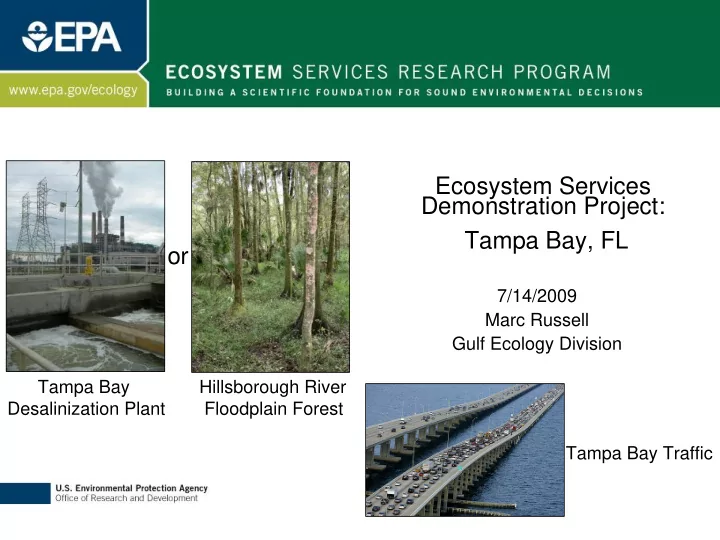

Ecosystem Services Demonstration Project: Tampa Bay, FL or 7/14/2009 Marc Russell Gulf Ecology Division Tampa Bay Hillsborough River Desalinization Plant Floodplain Forest Tampa Bay Traffic
Benefits Ecosystem Services Introduction Alternative Futures 2
3
Functions, Services, and, Benefits = + = Functions and Final Service Use Benefit Intermediate Services 4
Project Adjustments and Refinement Research Focus Prioritization Research Focus Prioritization 30% � � Technical advisory group Technical advisory group 25% • Steering committee and local 20% expert input � � 15% Economic value Economic value • Collaboration with Economist = 10% Initial valuation index 5% � � Local needs Local needs 0% • Workshop with stakeholder Water quality regulation Habitat functions Climate Regulation Fresh Water Supply Recreation Aesthetics Flood Control representatives • Identified priority management questions to address with research � � State of the science State of the science • Bibliometric analysis of Jordan et al. Submitted. Accounting for Natural Resources and knowledge gaps for important Environmental Sustainability: Linking Ecosystem Services to and valued ecosystem services 5 Human Well-Being
6 Landscape Characteristics Tampa Bay – Percent of TB Watershed 10 15 20 25 30 35 40 45 Urban 0 5 Agriculture Herbaceous 2006 Landscape Forest Wetland Barren Transportation
ES Spatial Accounting Units NHD+ Basins • Neighborhood scale • Linked to larger hydro-network • Ancillary info available 7
8
Carbon Storage Bank + Reduce potential C storage using percent canopy cover 9
Apply value from Chicago Carbon Exchange ($15 / ton C) and apportion to NHD+ basins (Total = $1.8 billion) 10
Particulate Matter Removal Improves human well-being: direct health benefit 11 Attainment of PM standards = $14-55 Billion worth of nationwide health benefits
Denitrification � � Freshwater wetlands provide Freshwater wetlands provide large potential for nitrogen large potential for nitrogen removal. removal. � � Mostly located upstream of Mostly located upstream of urbanized areas near the urbanized areas near the coast. coast. � � Future wetland losses may Future wetland losses may result in increased result in increased requirements for waste water requirements for waste water treatment to maintain water treatment to maintain water quality criteria. quality criteria. 12
Hotspots of denitrification potential still exist in the Tampa Bay region, with some NHD basins providing more than half 13 the removal capacity of an existing WTP.
+ = Beneficiaries Drainage Patterns NHD+ Denitrification 14
Bundled Services Example + 15
2060 2050 Alternative 2025 Scenarios – Land Cover/Use Public Process 2010 Modeled 2006 16
Projected Effects of 15-inch Sea-Level Rise 17 NWF Report 2006 “An Unfavorable Tide”
Questions? Skyway bridge across bay Hillsborough River Cypress Downtown Tampa 18 Alafia Banks Spoonbills Little Manatee River
Knowledge gaps and research proposals. 1) USGS National Climate Change and Wildlife Science Center 1) USGS National Climate Change and Wildlife Science Center • Nitrogen removal process rates under stressor gradients. � Hydrology, redox potential of soils, and temperature • Habitat support for biodiversity/valued species. 2) Urban Long Term Research Area (ULTRA- -EX) EX) - - NSF/USFS NSF/USFS 2) Urban Long Term Research Area (ULTRA • Nitrogen removal in riparian and mangrove buffers under urban stressor gradients. � Impervious surface, nitrogen loading • Social behavior/values in managing private land riparian buffers. 3) Gulf of Mexico Alliance (GOMA) 3) Gulf of Mexico Alliance (GOMA) • Urban lawn N isotope tracking • Social behavior, fertilizer ordinances, and regional impacts 4) ESRP – – Nitrogen Nitrogen 4) ESRP • Coupled wetland rapid condition assessment methods with nitrogen removal rate measurements under stressor gradients. � Landscape Development Intensity index (LDI), nutrient loads • Ecosystem nitrogen connectivity (stable isotopes/hydrological modeling) from upland forest through wetlands and into seagrass beds. 19
Wetland Site Selection Database � � HUC12 sub- -watersheds in the watersheds in the HUC12 sub Tampa Bay watershed were Tampa Bay watershed were mapped using the 2006 Florida mapped using the 2006 Florida Land Use, Land Cover Classification Land Use, Land Cover Classification System (FLUCCS) System (FLUCCS) � � 4 wetland classes (National 4 wetland classes (National Wetlands Inventory defined) Wetlands Inventory defined) • Estuarine emergent • Estuarine shrub-scrub • Palustrine emergent • Palustrine forested /shrub-scrub � � 3 landscape classes (Landscape 3 landscape classes (Landscape Development Intensity index) Development Intensity index) • LDI < 3.5 = High agriculture land use • LDI 3.5 - 5 = Mixed land use • LDI > 5 = High urban / developed land use � � This stratified This stratified- -random survey design random survey design provides 120 potential research provides 120 potential research 20 sites sites
Recommend
More recommend